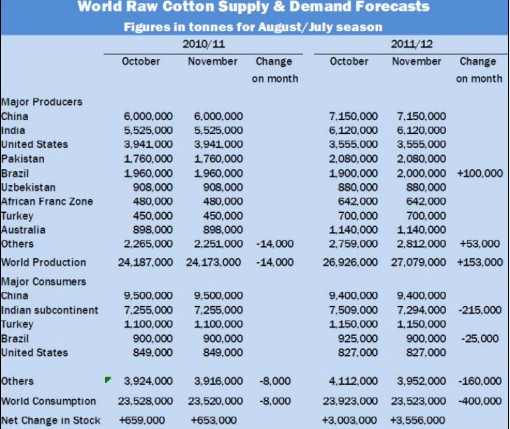|
International cotton price is undergoing another price spike recently. January 28, 2011, just several days before China's spring festival, when most textile companies taking off to celebrate, China Cotton Price Index rose 147 yuan, culminating at 28,648 yuan/ton. Multiple reasons led to this price upsurge, according to the consultative team of CHINA TEXTILE LEADER, one of the major reasons, however, was the sharp demand increase of China´s domestic market. Latest statistics unveiled by China Customs revealed that China´s importation of cotton in the single month of December was 461,592 tons, which is twice the quantity of November, which is 126,125 tons. China has imported 2.84 million tons of cotton in the year 2010, surging by 86 percent from the precedent year. Imported cotton accounted for as much as over half of the overall domestic output of China. Plus the side-effect of some natural disasters in the U.S and Australia, the supplying situation of cotton is gravitating toward a more worrisome direction. In addition, global cotton stocks have also been declining which one again exacerbated the stringent supply forecast. During the period of August 2008 to August 2009, cotton stocks accounted for 55 percent of the overall global cotton supply. This figure, however, plunged to 36.99 percent during the same period of 2009 and 2010. Experts of CHINA TEXTILE LEADER forecast that this figure will presumably keep going downward. China owns the largest plantation area of cotton and also bears the fame of world´s No.1 cotton consumers. But a large demand/supply gap emerges in the recent two years nonetheless. Overall cotton output of China in 2010 is 14.6 percent less than the previous year reaching 5.7 million tons. Professionals from China National Textile and Apparel Council forecast that world´s overall cotton demand in 2011 was 8 million tons whereas only 3.2 million tons could be imported to China. The stringent supply situation, therefore, seems irrevocable.
Adams, the NCC's vice president, Economics and Policy Analysis, said a key issue to watch will be the ability to sustain cotton demand in the prevailing market conditions, particularly given the uncertain nature of the macroeconomic recovery. He said that consumers in developing markets such as China and India will increasingly become the drivers of global retail cotton demand. ''Growth in cotton demand bodes well for total cotton trade," Adams said.''Increased mill use in China will require additional imports as available cotton stocks remain at low levels. In fact, for most countries, beginning stocks for the 2011 marketing year are at the lowest levels in recent years, and leave little room for further reductions during the upcoming marketing year.'' He said the increased import demand will create a positive environment for U.S. cotton exports, which are forecast at 15.6 million bales for the 2011 marketing year - the second highest level after the 2005 marketing year. The economist said that when combined with projected U.S. mill cotton use of 3.8 million bales, the demand base for U.S. cotton totals 19.3 million bales for the 2011 marketing year - although with little cotton being carried forward, U.S. cotton offtake could be dictated by the 2011 crop´s size. The NCC Planting Intentions Survey revealed that U.S. all-cotton plantings in 2011 of 12.5 million acres (14 percent higher than 2010) should generate a crop of 19.2 million bales, 18.5 million bales of upland and 671,000 bales of extra-long staple. ''With a projected U.S. crop smaller than total offtake, U.S. cotton stocks are expected to fall to 2.1 million bales by the end of the 2011 marketing year,'' Adams said. ''Globally, a modest increase in stocks is projected, but the overall stocks-to-use relationship does not materially change from 2010.'' China Textile Leader |
|
Tight Cotton Supply/Demand Situation to Continue in 2011
Updated: 2011-2-28 Source: China Textile Leader

Recommended News
Photo Gallery
Most Popular



